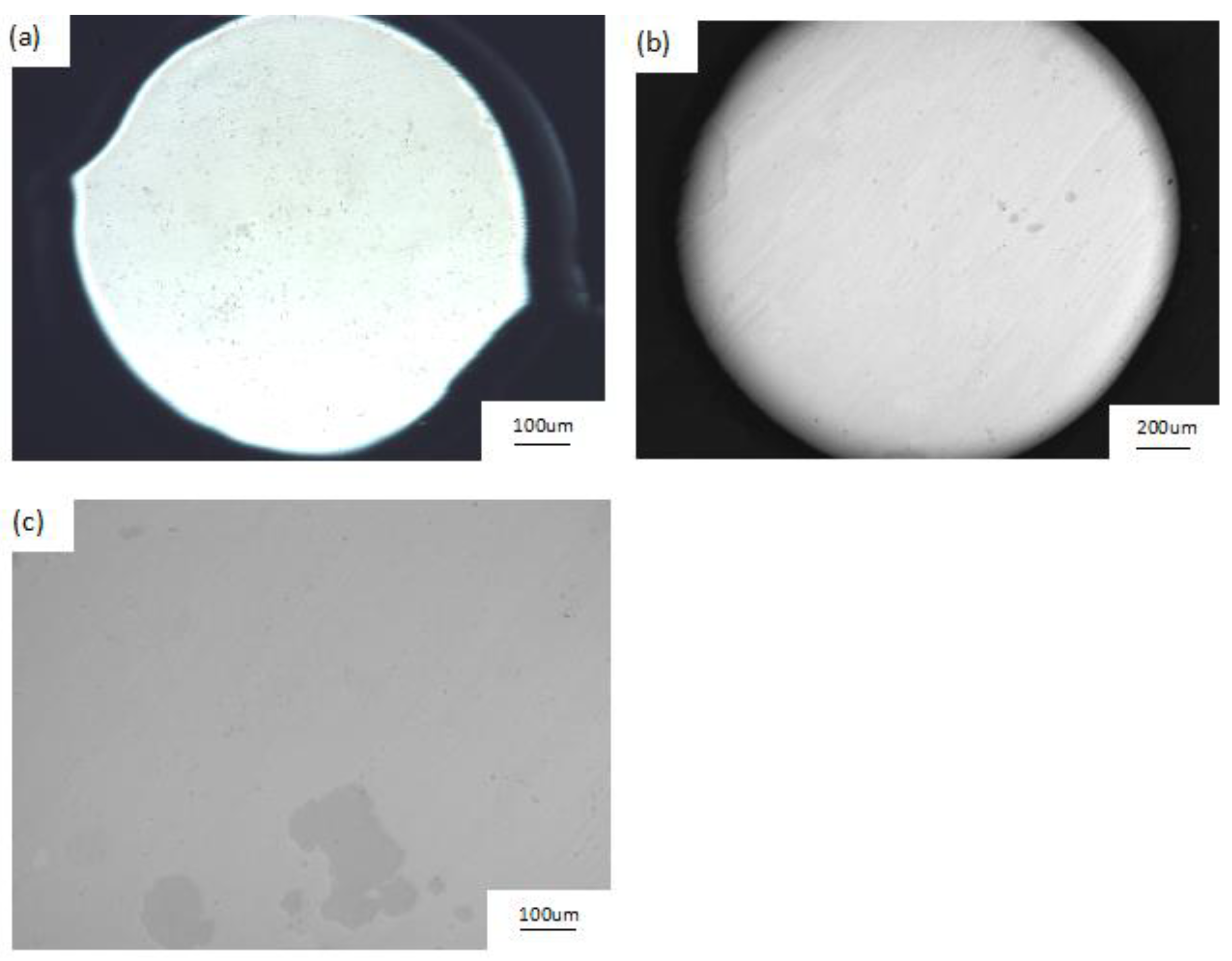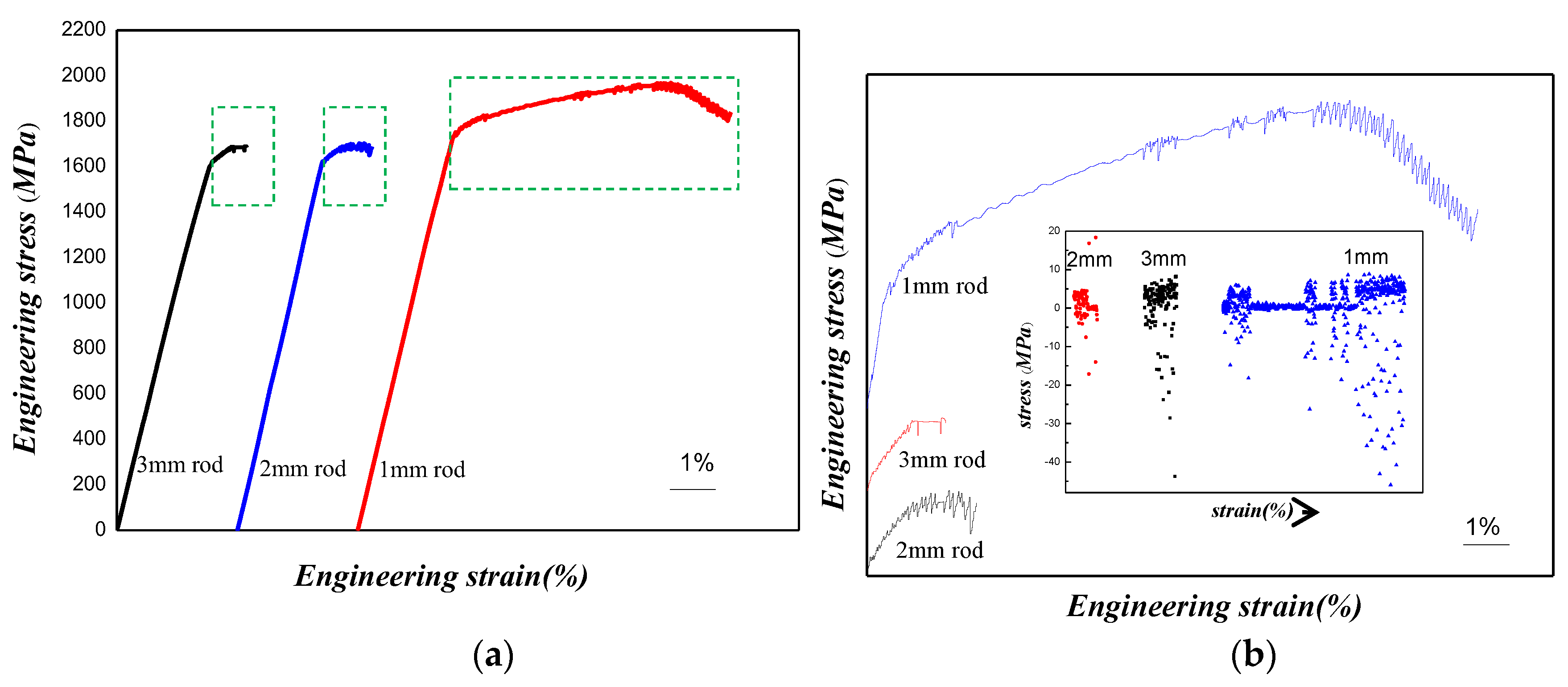Effect of Sample-Size on the Compression Deformation Behavior of a CuZr-Based Bulk Metallic Glass Composite
Abstract
1. Introduction
2. Experimental Procedure
3. Results and Discussion
4. Conclusions
Author Contributions
Funding
Acknowledgments
Conflicts of Interest
References
- Révész, Á.; Kovács, Z. Severe plastic deformation of amorphous alloys(Review). Mater. Trans. 2019, 60, 1283–1293. [Google Scholar] [CrossRef]
- Ning, Z.; Liang, W.; Zhang, M.-X.; Li, Z.; Sun, H.; Liu, A.; Sun, J. High tensile plasticity and strength of a CuZr-based bulk metallic glass composite. Mater. Des. 2016, 90, 145–150. [Google Scholar] [CrossRef]
- Mandal, S.; Kailath, A.J. Enhanced Plasticity of Cu-Zr-Ti Bulk Metallic Glass and Its Correlation with Fragility. Metall. Mater. Trans. A 2018, 50, 199–208. [Google Scholar] [CrossRef]
- Zhou, W.; Hu, J.; Weng, W.; Gao, L.; Xu, G. Enhancement of plasticity in Zr-Cu-Ni-Al-Ti bulk metallic glass by heterogeneous microstructure. J. Non-Crystalline Solids 2018, 481, 530–536. [Google Scholar] [CrossRef]
- Qiao, J.; Chen, Y.H.; Lyu, G.J.; Song, K.K.; Pelletier, J.; Yao, Y. Mechanical Relaxation of a Ti36.2Zr30.3Cu8.3Fe4Be21.2 Bulk Metallic Glass: Experiments and Theoretical Analysis. Acta Metall. Sin. (Eng. Lett.) 2018, 32, 726–732. [Google Scholar] [CrossRef]
- Wang, D.; Chen, Y.; Mu, J.; Zhu, Z.; Zhang, H.; Wang, Y.-D.; An, K. An in situ neutron diffraction study of plastic deformation in a Cu46.5Zr46.5Al7 bulk metallic glass composite. Scr. Mater. 2018, 153, 118–121. [Google Scholar] [CrossRef]
- Szuecs, F.; Kim, C.; Johnson, W. Mechanical properties of Zr56.2Ti13.8Nb5.0Cu6.9Ni5.6Be12.5 ductile phase reinforced bulk metallic glass composite. Acta Mater. 2001, 49, 1507–1513. [Google Scholar] [CrossRef]
- Chen, D.; Dong, J.-F.; Ma, G.-Z. Synthesis and compressive fracture behavior of a CuZr-based bulk amorphous alloy with Ti addition. J. Central South Univ. 2013, 20, 1137–1141. [Google Scholar] [CrossRef]
- Li, J.; Jang, J.; Li, C.; Jian, S.; Tsai, P.; Hwang, J.; Huang, J.; Nieh, T. Significant plasticity enhancement of ZrCu-based bulk metallic glass composite dispersed by in situ and ex situ Ta particles. Mater. Sci. Eng. A 2012, 551, 249–254. [Google Scholar] [CrossRef]
- Sun, H.C.; Ning, Z.; Wang, G.; Liang, W.Z.; Pauly, S.; Huang, Y.J.; Guo, S.; Xue, X.; Sun, J.F. In-situ tensile testing of ZrCu-based metallic glass composites. Sci. Rep. 2018, 8, 4651. [Google Scholar] [CrossRef]
- Zhai, H.-M.; Wang, H.-F.; Liu, F. Effect of minor Nb addition on mechanical properties of in-situ Cu-based bulk metallic glass composite. Trans. Nonferrous Met. Soc. China 2017, 27, 363–368. [Google Scholar] [CrossRef]
- Mahmoodan, M.; Gholamipour, R.Z.; Mirdamadi, S.; Nategh, S. Effect of Nb Content on Mechanical Behavior and Structural Properties of W/(Zr55Cu30Al10Ni5)100−xNbx Composite. Metall. Mater. Trans. A 2017, 48, 2496. [Google Scholar] [CrossRef]
- Wang, H.-S.; Wu, J.-Y.; Liu, Y.-T. Effect of the volume fraction of the ex-situ reinforced Ta additions on the microstructure and properties of laser-welded Zr-based bulk metallic glass composites. Intermetallics 2016, 68, 87–94. [Google Scholar] [CrossRef]
- Hofmann, U.C.; Suh, J.-Y.; Wiest, A.; Lind, M.-L.; Demetriou, M.D.; Johnson, W.L. Development of tough, low-density titanium-based bulk metallic glass matrix composites with tensile ductility. Proc. Natl. Acad. Sci. USA 2008, 105, 20136–20140. [Google Scholar] [CrossRef]
- Wang, X.; Jiang, F.; Hahn, H.; Li, J.; Gleiter, H.; Sun, J.; Fang, J. Sample size effects on strength and deformation mechanism of Sc75Fe25 nanoglass and metallic glass. Scr. Mater. 2016, 116, 95–99. [Google Scholar] [CrossRef]
- Zhang, Y.; Liu, J.; Chen, S.Y.; Xie, X.; Liaw, P.K.; Dahmen, K.A.; Qiao, J.W.; Wang, Y.L.; Zhang, Y. Serration and noise behaviors in materials. Prog. Mater. Sci. 2017, 90, 358–460. [Google Scholar] [CrossRef]
- Fan, J.; Wu, F.; Li, N. Dynamic compressive response of a dendrite-reinforced Ti-based bulk metallic glass composite. Mater. Sci. Eng. A 2018, 720, 140–144. [Google Scholar] [CrossRef]
- Wu, F.; Zheng, W.; Wu, S.; Zhang, Z.; Shen, J. Shear stability of metallic glasses. Int. J. Plast. 2011, 27, 560–575. [Google Scholar] [CrossRef]
- Xiao, Y.; Wu, Y.; Liu, Z.; Wu, H.-H.; Lü, Z. Effects of cooling rates on the mechanical properties of a Ti-based bulk metallic glass. Sci. China Ser. G Phys. Mech. Astron. 2010, 53, 394–398. [Google Scholar] [CrossRef]
- Liang, M.; Zhu, Y.; Ji, Z.; Fu, J.; Zheng, C. Effect of laser shock peening and its size-dependence on the compressive plasticity of Zr-based bulk metallic glass. J. Mater. Process. Technol. 2018, 251, 47–53. [Google Scholar] [CrossRef]
- Lin, X.H.; Johnson, W.L. Formation of Ti–Zr–Cu–Ni bulk metallic glasses. J. Appl. Phys. 1995, 78, 6514–6519. [Google Scholar] [CrossRef]
- Slipenyuk, A.; Eckert, J. Correlation between enthalpy change and free volume reduction during structural relaxation of Zr55Cu30Al10Ni5 metallic glass. Scr. Mater. 2004, 50, 39–44. [Google Scholar] [CrossRef]
- Okulov, I.; Soldatov, I.; Gokuldoss, P.K.; Sarac, B.; Spieckermann, F.; Eckert, J. Fabrication of Metastable Crystalline Nanocomposites by Flash Annealing of Cu47.5Zr47.5Al5 Metallic Glass Using Joule Heating. Nanomaterials 2020, 10, 84. [Google Scholar] [CrossRef] [PubMed]
- Kaban, I.; Khalouk, K.; Gasser, F.; Gasser, J.-G.; Bednarcik, J.; Shuleshova, O.; Okulov, I.; Gemming, T.; Mattern, N.; Eckert, J. In situ studies of temperature-dependent behaviour and crystallisation of Ni36.5Pd36.5P27 metallic glass. J. Alloys Compd. 2014, 615, S208–S212. [Google Scholar] [CrossRef]
- Wu, Y.; Li, H.; Liu, Z.; Chen, G.; Lu, Z. Interpreting size effects of bulk metallic glasses based on a size-independent critical energy density. Intermetallics 2010, 18, 157–160. [Google Scholar] [CrossRef]
- Zhang, Y.; Qiao, J.-W.; Liaw, P.K. A Brief Review of High Entropy Alloys and Serration Behavior and Flow Units. J. Iron Steel Res. Int. 2016, 23, 2–6. [Google Scholar] [CrossRef]
- He, M.; Zhang, Y.; Xia, L.; Yu, P. Kinetics and thermal stability of the Ni62Nb38−xTax (x=5, 10, 15, 20 and 25) bulk metallic glasses. Sci. China Ser. G Phys. Mech. Astron. 2017, 60, 42. [Google Scholar] [CrossRef]
- Kim, B.J.; Yun, Y.S.; Kim, W.T.; Kim, D. Phase formation and mechanical properties of Cu-Zr-Ti bulk metallic glass composites. Met. Mater. Int. 2016, 22, 1026–1032. [Google Scholar] [CrossRef]
- Narayan, R.L.; Singh, P.; Hofmann, D.; Hutchinson, N.; Flores, K.; Ramamurty, U. On the microstructure–tensile property correlations in bulk metallic glass matrix composites with crystalline dendrites. Acta Mater. 2012, 60, 5089–5100. [Google Scholar] [CrossRef]
- Chung, T.-M.; Jian, S.-R.; Hsieh, P.-J. The Effect of Ag Addition on the Enhancement of the Thermal and Mechanical Properties of CuZrAl Bulk Metallic Glasses. Metals 2016, 6, 216. [Google Scholar] [CrossRef]
- Chen, L.; Fu, Z.D.; Zhang, G.Q.; Hao, X.P.; Jiang, Q.K.; Wang, X.D.; Cao, Q.P.; Franz, H.; Liu, Y.G.; Xie, H.S.; et al. New Class of Plastic Bulk Metallic Glass. Phys. Rev. Lett. 2008, 100, 075501. [Google Scholar] [CrossRef] [PubMed]
- Sun, H.; Ning, Z.; Ren, J.; Liang, W.; Huang, Y.; Sun, J.; Xue, X.; Wang, G. Serration and shear avalanches in a ZrCu based bulk metallic glass composite in different loading methods. J. Mater. Sci. Technol. 2019, 35, 2079–2085. [Google Scholar] [CrossRef]
- Xie, S.; George, E.P. Size-dependent plasticity and fracture of a metallic glass in compression. Intermetallics 2008, 16, 485–489. [Google Scholar] [CrossRef]






© 2020 by the authors. Licensee MDPI, Basel, Switzerland. This article is an open access article distributed under the terms and conditions of the Creative Commons Attribution (CC BY) license (http://creativecommons.org/licenses/by/4.0/).
Share and Cite
Chen, Y.; Liang, W.; Wang, L.; Qi, K.; Wang, Y.; Sun, X.; Fang, N. Effect of Sample-Size on the Compression Deformation Behavior of a CuZr-Based Bulk Metallic Glass Composite. Metals 2020, 10, 857. https://doi.org/10.3390/met10070857
Chen Y, Liang W, Wang L, Qi K, Wang Y, Sun X, Fang N. Effect of Sample-Size on the Compression Deformation Behavior of a CuZr-Based Bulk Metallic Glass Composite. Metals. 2020; 10(7):857. https://doi.org/10.3390/met10070857
Chicago/Turabian StyleChen, Yongsheng, Weizhong Liang, Longxing Wang, Kai Qi, Yang Wang, Xiaomei Sun, and Naiwen Fang. 2020. "Effect of Sample-Size on the Compression Deformation Behavior of a CuZr-Based Bulk Metallic Glass Composite" Metals 10, no. 7: 857. https://doi.org/10.3390/met10070857
APA StyleChen, Y., Liang, W., Wang, L., Qi, K., Wang, Y., Sun, X., & Fang, N. (2020). Effect of Sample-Size on the Compression Deformation Behavior of a CuZr-Based Bulk Metallic Glass Composite. Metals, 10(7), 857. https://doi.org/10.3390/met10070857



